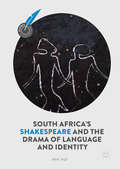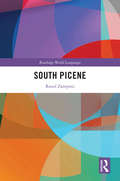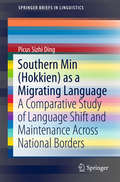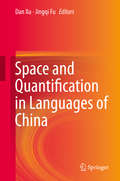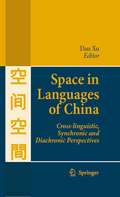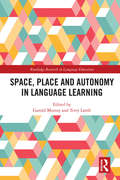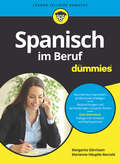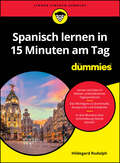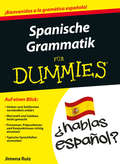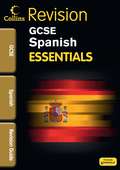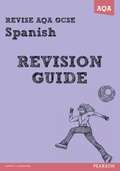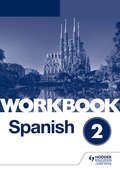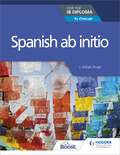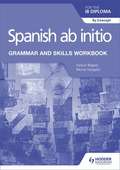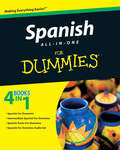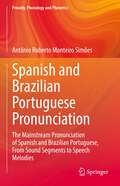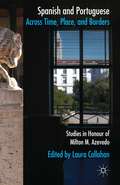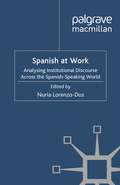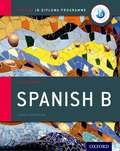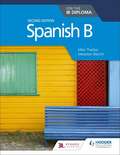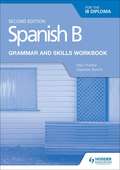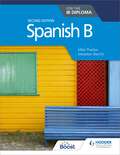- Table View
- List View
South Africa's Shakespeare and the Drama of Language and Identity (Global Shakespeares)
by Adele SeeffThis volume considers the linguistic complexities associated with Shakespeare’s presence in South Africa from 1801 to early twentieth-first century televisual updatings of the texts as a means of exploring individual and collective forms of identity. A case study approach demonstrates how Shakespeare’s texts are available for ideologically driven linguistic programs. Seeff introduces the African Theatre, Cape Town, in 1801, multilingual site of the first recorded performance of a Shakespeare play in Southern Africa where rival, amateur theatrical groups performed in turn, in English, Dutch, German, and French. Chapter 3 offers three vectors of a broadening Shakespeare diaspora in English, Afrikaans, and Setswana in the second half of the nineteenth century. Chapter 4 analyses André Brink’s Kinkels innie Kabel, a transposition of Shakespeare’s The Comedy of Errors into Kaaps, as a radical critique of apartheid’s obsession with linguistic and ethnic purity. Chapter 5 investigates John Kani’s performance of Othello as a Xhosa warrior chief with access to the ancient tradition of Xhosa storytellers. Shakespeare in Mzansi, a televisual miniseries uses black actors, vernacular languages, and local settings to Africanize Macbeth and reclaim a cross-cultural, multilingualism. An Afterword assesses the future of Shakespeare in a post-rainbow, decolonizing South Africa. Global Sha Any reader interested in Shakespeare Studies, global Shakespeare, Shakespeare in performance, Shakespeare and appropriation, Shakespeare and language, Literacy Studies, race, and South African cultural history will be drawn to this book.
South Picene (Routledge World Languages)
by Raoul ZamponiSouth Picene is the pre-Roman language spoken in the Adriatic sector of central Italy. This book presents a description of what we know about the structure of this language. South Picene is (together with Umbrian, Oscan, Latin, and Faliscan) one of the few members of the Italic branch of the Indo-European family and is also one of the European languages with the oldest existing texts (550 BCE). Besides a grammatical outline of the language, the book contains the linguistic (and often stylistic) analysis of all the 21 inscriptions that compose the South Picene epigraphic corpus and a word list. South Picene will be of interest to students and scholars of Indo-European languages, Italic languages, and in general, ancient languages of the Italian peninsula.
South Picene (Routledge World Languages)
by Raoul ZamponiSouth Picene is the pre-Roman language spoken in the Adriatic sector of central Italy. This book presents a description of what we know about the structure of this language. South Picene is (together with Umbrian, Oscan, Latin, and Faliscan) one of the few members of the Italic branch of the Indo-European family and is also one of the European languages with the oldest existing texts (550 BCE). Besides a grammatical outline of the language, the book contains the linguistic (and often stylistic) analysis of all the 21 inscriptions that compose the South Picene epigraphic corpus and a word list. South Picene will be of interest to students and scholars of Indo-European languages, Italic languages, and in general, ancient languages of the Italian peninsula.
Southern Min: A Comparative Study of Language Shift and Maintenance Across National Borders (SpringerBriefs in Linguistics #0)
by Picus Sizhi DingThis book presents multilingualism as a social phenomenon, which arises when speakers of a different language move to a new society and learn to speak the dominant language of the society. It offers case studies of Hokkien migrating families when they encounter new languages in Burma, Macao and San Francisco, showing how a family changes across generations from monolingual to bilingual/multilingual and back to monolingual. In the process language shift occurs as a result of transitional bilingualism. The dynamic status of Hokkien is also attested at the societal level in Singapore, Taiwan and south Fujian, the homeland of Hokkien.
Space and Quantification in Languages of China
by Dan Xu Jingqi FuThis volume provides general linguists with new data and analysis on languages spoken in China regarding various aspects of space and quantification, using different approaches. Contributions by researchers from Mainland China, Hong Kong, Japan, Europe, the United States and Australia offer insights on aspects of language ranging from phonology and morphology to syntax and semantics, while the approaches vary from formal, historical, areal, typological, and cognitive linguistics to second language acquisition. After separate volumes on space and quantification in languages of China, the studies in this volume combine space and quantification to allow readers a view of the intersection of the two topics. Each article contributes to general linguistic knowledge while discussing a particular aspect of space or quantification in a particular language/dialect, offering new data and analysis from languages that are spoken in the same geographical area, and that belong to various language families that exist and evolve in close contact with one another.
Space in Languages of China: Cross-linguistic, Synchronic and Diachronic Perspectives
by Dan XuSpace has long been a popular topic in linguistic research. Numerous books on the subject have been published over the past decade. However, none of these books were based on linguistic data from Chinese and expressions of space in Chinese have been largely neglected in past research. In this volume, not only Mandarin Chinese (the standard language) is investigated; several other dialects, as well as a minority language of China and Chinese Sign Language are studied. Cross-linguistic, synchronic and diachronic approaches are used to investigate phenomena related to space. The authors of this book present different points of view on the expression of space in language and related theoretical issues. As the contributing scholars argue, Chinese shares many common features with other languages, but also presents some particular properties. Space is a topic that is both classical and modern, of enduring interest. These studies of space give insight into not only general linguistics but also other domains such as anthropology and psychology.
Space, Place and Autonomy in Language Learning (Routledge Research in Language Education)
by Garold Murray Terry LambThis book explores theories of space and place in relation to autonomy in language learning. Encompassing a wide range of linguistically and culturally diverse learning contexts, this edited collection brings together research papers from academics working in fourteen countries. In their studies, these researchers examine physical, virtual and metaphorical learning spaces from a wide range of theoretical and interdisciplinary perspectives (semiotic, ecological, complexity, human geography, linguistic landscapes, mediated discourse analysis, sociocultural, constructivist and social constructivist) and methodological approaches. The book traces its origins to the first-ever symposium on space, place and autonomy, which was held at the International Association of Applied Linguistics (AILA) 2014 World Congress in Brisbane. The final chapter, which presents a thematic analysis of the papers in this volume, discusses the implications for theory development, further enquiry, and pedagogical practice.
Space, Place and Autonomy in Language Learning (Routledge Research in Language Education)
This book explores theories of space and place in relation to autonomy in language learning. Encompassing a wide range of linguistically and culturally diverse learning contexts, this edited collection brings together research papers from academics working in fourteen countries. In their studies, these researchers examine physical, virtual and metaphorical learning spaces from a wide range of theoretical and interdisciplinary perspectives (semiotic, ecological, complexity, human geography, linguistic landscapes, mediated discourse analysis, sociocultural, constructivist and social constructivist) and methodological approaches. The book traces its origins to the first-ever symposium on space, place and autonomy, which was held at the International Association of Applied Linguistics (AILA) 2014 World Congress in Brisbane. The final chapter, which presents a thematic analysis of the papers in this volume, discusses the implications for theory development, further enquiry, and pedagogical practice.
Spanisch im Beruf für Dummies (Für Dummies)
by Margarita Görrissen Marianne Häuptle-BarcelóSie müssen auf Spanisch mit Ihren Kollegen, Kunden und Geschäftspartnern kommunizieren? Wenn Sie dieses Buch gelesen haben, werden Sie entspannt Telefongespräche auf Spanisch führen und Geschäftskorrespondenz jeglicher Art auf Spanisch verfassen. Sie erfahren, wie Sie sich bei Besprechungen und Verhandlungen von Ihrer besten Seite zeigen und lernen den Small Talk beim Networking zu beherrschen. Die Autorinnen geben Ihnen Tipps, nennen Ihnen die wichtigsten Redewendungen und erläutern kulturelle Gepflogenheiten in Spanien und Lateinamerika. So tauchen Sie ganz leicht in die spanischsprachige Geschäftswelt ein.
Spanisch lernen in 15 Minuten am Tag für Dummies (Für Dummies)
by Hildegard RudolphNur ein Viertelstündchen Spanisch am Tag Sie wollen Spanisch lernen, ohne stundenlang Vokabeln und Grammatik zu pauken? Dann ist dieses Buch genau das Richtige für Sie! In auf 15 Minuten pro Tag begrenzten Lektionen bringt es Ihnen die spanische Sprache näher. So erfahren Sie im Handumdrehen alles Wichtige über Grammatik und Aussprache und erweitern Ihren Wortschatz. Mit regelmäßigen Wiederholungsfragen können Sie Ihr Wissen testen. Zum Download verfügbares Audiomaterial rundet die Lektionen ab. So werden Sie, wenn Sie nach drei Monaten das Buch durchgearbeitet haben, in der Lage sein, sich auf Spanisch zu verständigen. Sie erfahren Wie Sie in jeder Situation die richtigen Worte finden Mit welchen Redewendungen Sie brillieren Welche Wörter Sie nicht verwechseln sollten Wie Sie das Spanische richtig aussprechen
Spanische Grammatik für Dummies (Für Dummies)
by Jimena RuizMit Übungsaufgaben samt Lösungen und Konjugationstabellen der wichtigsten Verben Grammatik ist nicht jedermanns Sache und die spanische Grammatik macht es einem auch nicht immer leicht. Jimena Ruiz unterrichtet seit vielen Jahren Spanisch. Sie kennt die Nöte der Lernenden und die Fallen der spanischen Grammatik, in die sie häufig hineintappen. Leicht verständlich, mit einer Prise Humor und anhand vieler Beispiele und Informationen zu Land und Leuten erklärt sie alles über Artikel und Pronomen, Adjektive und Adverbien, Fragestellung und Verneinung, die Zeiten und die Satzstellung. Am Ende eines jeden Kapitels gibt es Übungen, die das Gelernte noch einmal wiederholen. Tabellen der wichtigsten spanischen Verben bieten ganz Eiligen alle Konjugationen auf einen Blick. So sind Sie für den nächsten Test gerüstet, können mit Ihren spanischen Kollegen über zukünftige Projekte sprechen oder einfach nur unbeschwert im Spanienurlaub parlieren.
Spanish: Revision Guide (PDF)
by Terry MurrayThe student-friendly, uncluttered approach to GCSE revision, guides students through the core Spanish content with succinct revision notes and practice questions that focus on the essential content needed for the exams.
Spanish: Revision Guide (PDF)
by Leanda Reeves Tracy TraynorThis Revision Guide delivers exam preparation, covering one topic per page and closely matching the AQA specification. Target grades on the page help you to progress at the right speed. Exam Alerts highlight common pitfalls and misconceptions in exam questions. Audio files are available free on a companion website to provide realistic question practice.
Spanish A-level Grammar Workbook 2 (PDF)
by Hodder EducationBuild confidence in Spanish grammar with hundreds of activities to embed the grammar knowledge necessary for exam success.Suitable for all exam boards and abilities, this Spanish A-level Grammar Workbook will help students to:- Extend their learning beyond the classroom by supplementing key resources such as course textbooks- Develop their understanding with clear explanations of grammatical rules and exceptions- Improve confidence with 251 exercises which build in complexity for each grammar point- Strengthen translation skills by putting grammar into practice with 72 translation exercises- Make the most of opportunities for self-directed learning and assessment with answers to activities supplied online
Spanish ab initio for the IB Diploma: by Concept
by J. Rafael AngelEnsure that the needs of all IB Students are met with this comprehensive and flexible Student Book, written specifically for the updated Spanish ab initio course. - Communicate confidently by exploring the five prescribed themes through authentic texts and skills practice at the right level, delivered in clear learning pathways. - Produce coherent written texts and deliver proficient presentations with grammar and vocabulary introduced in context and in relation to appropriate spoken and written registers. - Improve receptive skills with authentic written texts, audio recordings spoken at a natural pace, and carefully crafted reading and listening tasks.- Promote global citizenship, intercultural understanding and an appreciation of Hispanic cultures through a wide range of text types and cultural material from around the world. - Deliver effective practice with a range of structured tasks within each unit that build reading, listening, speaking and writing skills.- Establish meaningful links to TOK and CAS, and identify learner profile attributes in action.The audio for the Student Book is FREE to download from www.hoddereducation.com/ibextrasAnswers to the Student Book are included in the accompanying subscription based, Teaching and Learning Resources
Spanish ab initio for the IB Diploma Grammar and Skills Workbook
by Monia Voegelin Kasturi BagweBuild confidence for the written and oral assessments with hours of essential grammar practice activities and opportunities to develop writing skills. - Ensure structured language practice through comprehensive coverage of all IB grammar points and in-depth practice of core reading and writing skills based around the main text types.
Spanish All-in-One For Dummies
by The Experts at DummiesA value-packed guide to speaking, reading, and writing in Spanish Spanish All-in-One For Dummies is the first Dummies All-in-One title in the foreign language category–nearly 800 pages of expert instruction to help people master Spanish basics and beyond. This comprehensive volume features content from all For Dummies Spanish language instruction titles, including Spanish For Dummies, Intermediate Spanish For Dummies, Spanish Verbs For Dummies, and Spanish For Dummies Audio Set. The book's audio CD provides readers with an effective tool to help them start speaking Spanish from day one. Plus, the practical exercises give readers greater confidence in communicating in Spanish, whether traveling or in business.
Spanish All-in-One For Dummies
by The Experts at DummiesA value-packed guide to speaking, reading, and writing in Spanish Spanish All-in-One For Dummies is the first Dummies All-in-One title in the foreign language category–nearly 800 pages of expert instruction to help people master Spanish basics and beyond. This comprehensive volume features content from all For Dummies Spanish language instruction titles, including Spanish For Dummies, Intermediate Spanish For Dummies, Spanish Verbs For Dummies, and Spanish For Dummies Audio Set. The book's audio CD provides readers with an effective tool to help them start speaking Spanish from day one. Plus, the practical exercises give readers greater confidence in communicating in Spanish, whether traveling or in business.
Spanish and Brazilian Portuguese Pronunciation: The Mainstream Pronunciation of Spanish and Brazilian Portuguese, From Sound Segments to Speech Melodies (Prosody, Phonology and Phonetics)
by Antônio Roberto SimõesThis book contrasts variations in Spanish and Brazilian Portuguese pronunciation, using as a reference for discussion the mainstream careful speech of news anchors at the national level or the equivalent type of speech: a well-educated style that nonetheless sounds natural. Pursuing an innovative approach, the book uses this view of language as a cornerstone to describe and discuss other social and regional variants relative to that speaking register. It is aimed at speakers of Spanish interested in learning Portuguese and speakers of Portuguese who want to learn Spanish, as well as language specialists interested in bilingualism, heritage languages, in the teaching of typologically similar languages in contrast, and readers with interest in Phonetics and Phonology. The book employs a variety of innovative approaches, especially the reinterpretation of some of the traditional concept in Phonetics, and the use of speech prosodies and speech melodies, a user-friendly strategy to describe speech prosody in languages and speech melody in music through musical notation.
Spanish and Portuguese across Time, Place, and Borders: Studies in Honour of Milton M. Azevedo
by Laura CallahanSpanish and Portuguese Across Time covers a diverse range of topics with a common focus, on the dynamic nature of languages and the social forces that shape them across time, place, and borders, and demonstrates how linguistic principles can offer productive angles to the study of literature.
Spanish at Work: Analysing Institutional Discourse across the Spanish-Speaking World
by Nuria Lorenzo-DusA state-of-the-art collection of works on institutional discourse across the Spanish-speaking world. This volume focuses on how language is used in the media, politics and the workplace; what discursive identities are constructed; and how interpersonal relations are negotiated.
Spanish B: Course Companion (Second Edition) (PDF) (IB Diploma Program Ser.)
by Laura Cisneros Ana ValbuenaFully addressing all aspects of the 2018 syllabus at SL and HL, this rich and challenging course book pack drives confidence and achievement in Spanish B.
Spanish B for the IB Diploma (2nd edition) (PDF)
by Mike Thacker Sebastian BianchiExam board: International BaccalaureateLevel: IB DiplomaSubject: SpanishFirst teaching: September 2018First exams: Summer 2020Develop competent communicators who can demonstrate a sound conceptual understanding of the language with a flexible course that ensures thorough coverage of the updated Spanish B Guide and is designed to meet the needs of all IB students at Standard and Higher Level.- Empower students to communicate confidently by exploring the five prescribed themes through authentic texts and skills practice at the right level, delivered in clear learning pathways. - Ensure students are able to produce coherent written texts and deliver proficient presentations with grammar and vocabulary introduced in context and in relation to appropriate spoken and written registers. - Improve receptive skills with authentic written texts, audio recordings spoken at a natural pace, and carefully crafted reading and listening tasks.- Promote global citizenship, intercultural understanding and an appreciation of Hispanic cultures through a wide range of text types and cultural material from around the world. - Deliver effective practice with a range of structured tasks within each unit that build reading, listening, speaking and writing skills.- Establish meaningful links to TOK and CAS, and identify learner profile attributes in action.The audio for the Student Book is FREE to download from www.hoddereducation.com/ibextras
Spanish B for the IB Diploma Grammar and Skills Workbook Second edition
by Mike Thacker Sebastian BianchiBuild confidence for the written and oral assessments with hours of essential grammar practice activities and opportunities to develop writing skills. -Ensure structured language practice through comprehensive coverage of all IB grammar points and in-depth practice of core reading and writing skills based around the main text types.-Provide revision opportunities alongside material for ab initio students in the Transition section.-Effectively teach students at two levels with differentiated activities at Standard and Higher level.-Challenge Higher Level students with extension activities and specific advice.
Spanish B for the IB Diploma Second Edition
by Mike Thacker Sebastian BianchiExam board: International BaccalaureateLevel: IB DiplomaSubject: SpanishFirst teaching: September 2018First exams: Summer 2020Develop competent communicators who can demonstrate a sound conceptual understanding of the language with a flexible course that ensures thorough coverage of the updated Spanish B Guide and is designed to meet the needs of all IB students at Standard and Higher Level.- Empower students to communicate confidently by exploring the five prescribed themes through authentic texts and skills practice at the right level, delivered in clear learning pathways. - Ensure students are able to produce coherent written texts and deliver proficient presentations with grammar and vocabulary introduced in context and in relation to appropriate spoken and written registers. - Improve receptive skills with authentic written texts, audio recordings spoken at a natural pace, and carefully crafted reading and listening tasks.- Promote global citizenship, intercultural understanding and an appreciation of Hispanic cultures through a wide range of text types and cultural material from around the world. - Deliver effective practice with a range of structured tasks within each unit that build reading, listening, speaking and writing skills.- Establish meaningful links to TOK and CAS, and identify learner profile attributes in action.The audio for the Student Book is FREE to download from www.hoddereducation.com/ibextras
